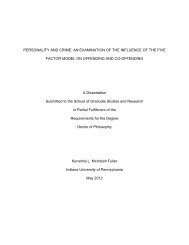An-Evaluation-of-Spearmans-Hypothesis-by-Manipulating-g-Saturation
An-Evaluation-of-Spearmans-Hypothesis-by-Manipulating-g-Saturation
An-Evaluation-of-Spearmans-Hypothesis-by-Manipulating-g-Saturation
- No tags were found...
You also want an ePaper? Increase the reach of your titles
YUMPU automatically turns print PDFs into web optimized ePapers that Google loves.
334 Michael A. McDaniel and Sven Kepes<br />
man’s <strong>Hypothesis</strong> literature. We conclude the paper<br />
with a discussion <strong>of</strong> the usefulness <strong>of</strong> Spearman’s <strong>Hypothesis</strong><br />
in understanding the results <strong>of</strong> g tests that<br />
appear to have lower than typical Black–White mean<br />
differences.<br />
When evaluating data with respect to Spearman’s <strong>Hypothesis</strong><br />
and the determination <strong>of</strong> the g saturation <strong>of</strong><br />
tests, there are three classes <strong>of</strong> issues that should be<br />
considered (Carroll, 1993; Floyd, Shands, Rafael,<br />
Bergeron, & McGrew, 2009; Major, Johnson, &<br />
Bouchard, 2011). The first class <strong>of</strong> issues concerns<br />
sample characteristics. One issue in this class is the size<br />
<strong>of</strong> the sample. In this study, the samples were selected<br />
such that each sample had at least 25 Whites and 25<br />
Blacks, and summed across samples, we had data for<br />
16,384 individuals. Thus, we have more than an adequate<br />
sample size for the precise estimation <strong>of</strong> statistics.<br />
The second issue concerning samples is whether the<br />
samples are drawn from occupational settings. Our data<br />
were drawn from the General Aptitude Test Battery<br />
(GATB; U.S. Department <strong>of</strong> Labor, 1970) database, and<br />
all data are from occupational settings. The large<br />
amount <strong>of</strong> data enhances the likelihood <strong>of</strong> a representative<br />
set <strong>of</strong> data. Thus, our results should generalize to<br />
occupational settings.<br />
The second class <strong>of</strong> issues relates to the tests used in<br />
estimating g. One issue is the diversity <strong>of</strong> tests (Carroll,<br />
1993; Johnson & Bouchard, 2005; McGrew, 2009; Reeve<br />
& Blacksmith, 2009). A broad array <strong>of</strong> tests is typically<br />
recommended. Test composites may give too much<br />
weight to crystallized ability because fluid ability tests<br />
tend to be more narrowly defined tasks (e.g., number<br />
series), which may have more unique variance (Ashton<br />
& Lee, 2005; Kvist & Gustafsson, 2008). This can result<br />
in the crystallized components defining more <strong>of</strong> the<br />
common variance <strong>of</strong> g than other components (e.g., fluid<br />
intelligence). The nine GATB scales used in this study<br />
are drawn from a diverse set <strong>of</strong> 12 tests: name comparison,<br />
computation, three-dimensional space, vocabulary,<br />
tool matching, arithmetic reason, form matching, mark<br />
making, place, turn, assemble, disassemble. Of these<br />
tests, vocabulary appears to be the sole test that is<br />
clearly identifiable as crystallized. Arithmetic reason expresses<br />
problems verbally and may have some crystallized<br />
variance. Computation is addition, subtraction,<br />
multiplication, and division <strong>of</strong> whole numbers. Tool<br />
matching and form matching are perceptual measures.<br />
Name comparison is a speeded perception test. The remaining<br />
tests assess psychomotor abilities. Thus, the<br />
GATB incorporates a broad range <strong>of</strong> ability scales. Also<br />
in this class <strong>of</strong> issues is the number <strong>of</strong> tests used in<br />
estimating a g factor. Major et al. (2011) reported that a<br />
small number <strong>of</strong> scales or tests tend to inflate the factor<br />
loadings. Furthermore, factor loadings tend to be less<br />
reliable with few scales or tests. As a result, Major et al.<br />
encouraged the use <strong>of</strong> at least six to seven indicators<br />
(i.e., scales or tests) per factor. In our study, we have<br />
nine scales based on 12 separate tests. Thus, our factors<br />
can be well defined and the factor loadings can be well<br />
estimated.<br />
The third class <strong>of</strong> issues concerns the choice <strong>of</strong> factor<br />
extraction method. Both Floyd et al. (2009) and Major<br />
et al. (2011) reported that principal components analysis<br />
tends to overestimate general factor loadings relative to<br />
principal factor analysis. Jensen and Weng (1994) also<br />
recommended principal factor analysis. Consistent with<br />
these findings and recommendations, we used principal<br />
factor analysis.<br />
There are two likely scenarios for building a g composite<br />
to reduce its g saturation. Both involve altering<br />
the measurement <strong>of</strong> g so that a test assesses g less well.<br />
First, one can alter the assessment <strong>of</strong> g <strong>by</strong> dropping<br />
scales with high g saturation. This approach lowers the g<br />
saturation <strong>of</strong> a composite <strong>by</strong> excluding scales with the<br />
best g saturation. Second, one can alter the g saturation<br />
<strong>of</strong> the composite <strong>by</strong> adding random or near random<br />
variance to the composite. 1 This approach lowers the g<br />
saturation <strong>by</strong> reducing the reliability <strong>of</strong> the composite. In<br />
this paper, we use both methods in the evaluation <strong>of</strong><br />
Spearman’s <strong>Hypothesis</strong>.<br />
When reducing the number <strong>of</strong> tests in a composite,<br />
one might expect the reliability <strong>of</strong> the resulting composite<br />
to be smaller than the reliability <strong>of</strong> a composite with<br />
a larger number <strong>of</strong> tests. If the reliability drops as the<br />
number <strong>of</strong> tests in the composite drops, reliability<br />
decrements may be a cause <strong>of</strong> the decline in validity and<br />
mean group racial differences. Thus, effects attributed to<br />
the Spearman’s <strong>Hypothesis</strong> may simply be a result <strong>of</strong><br />
increases in measurement error. In this paper, we empirically<br />
address the credibility <strong>of</strong> this argument.<br />
2. Method<br />
2.1. Data source and measures<br />
The GATB is a set <strong>of</strong> nine cognitive scales that are used<br />
in various employment contexts. The nine scales are: G<br />
– general learning ability, V – verbal aptitude, N – numerical<br />
aptitude, S – spatial aptitude, P – form perception,<br />
Q – clerical perception, K – motor coordination, F<br />
– finger dexterity, and M – manual dexterity. From the<br />
U.S. Employment Service, U.S. Department <strong>of</strong> Labor,<br />
we obtained a data set containing GATB scores and job<br />
performance data. Data were formed into multiple<br />
samples consistent with past research <strong>by</strong> the U.S. Employment<br />
Service. 2 In each <strong>of</strong> these samples, the GATB<br />
was administered and job performance data were collected.<br />
We retained all samples that contained at least<br />
25 Whites and 25 Blacks, used an identical supervisory<br />
performance rating form as the criterion, and had<br />
no missing data on any GATB scale or the job<br />
International Journal <strong>of</strong> Selection and Assessment<br />
Volume 22 Number 4 December 2014<br />
©2014 John Wiley & Sons Ltd




